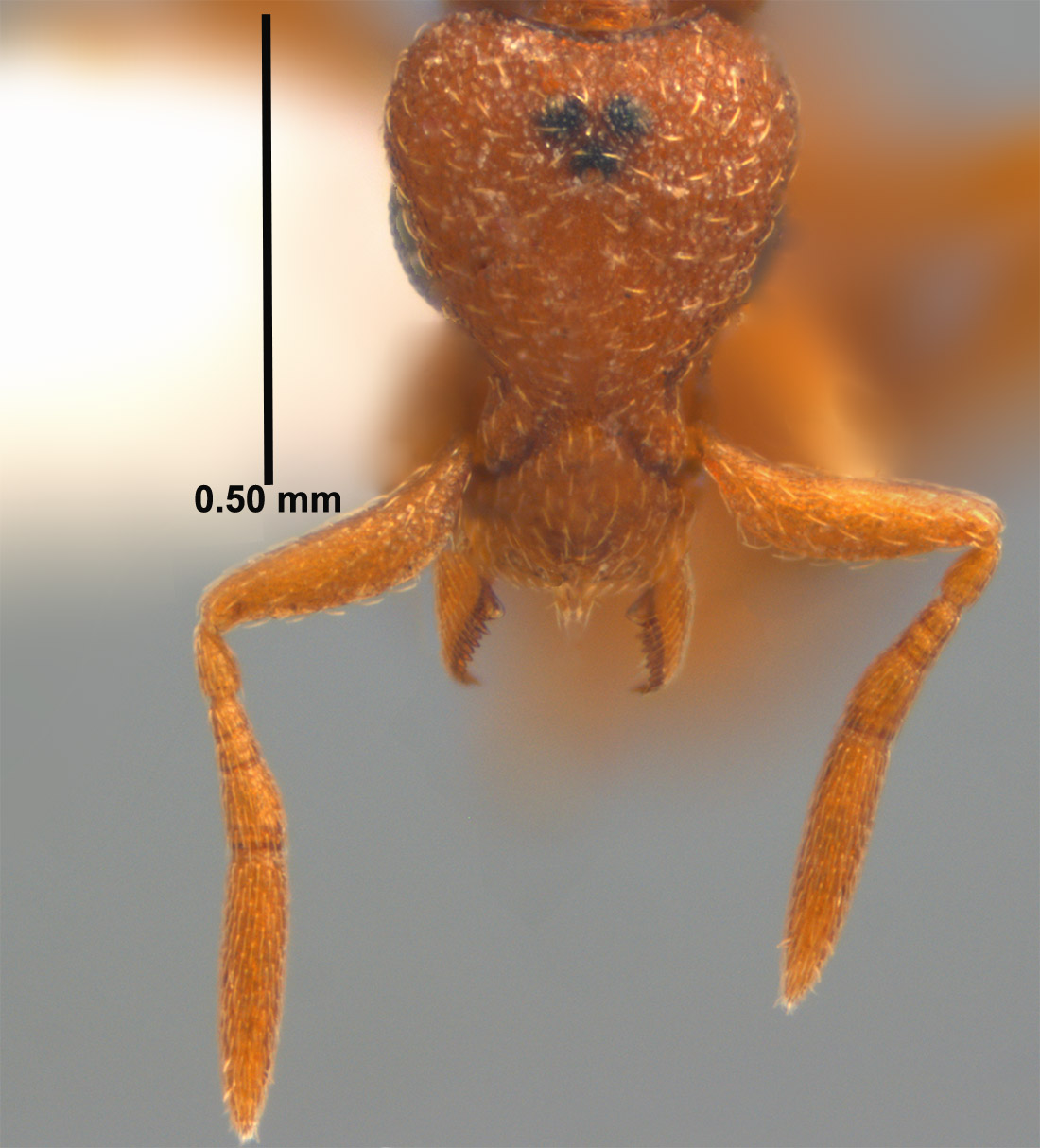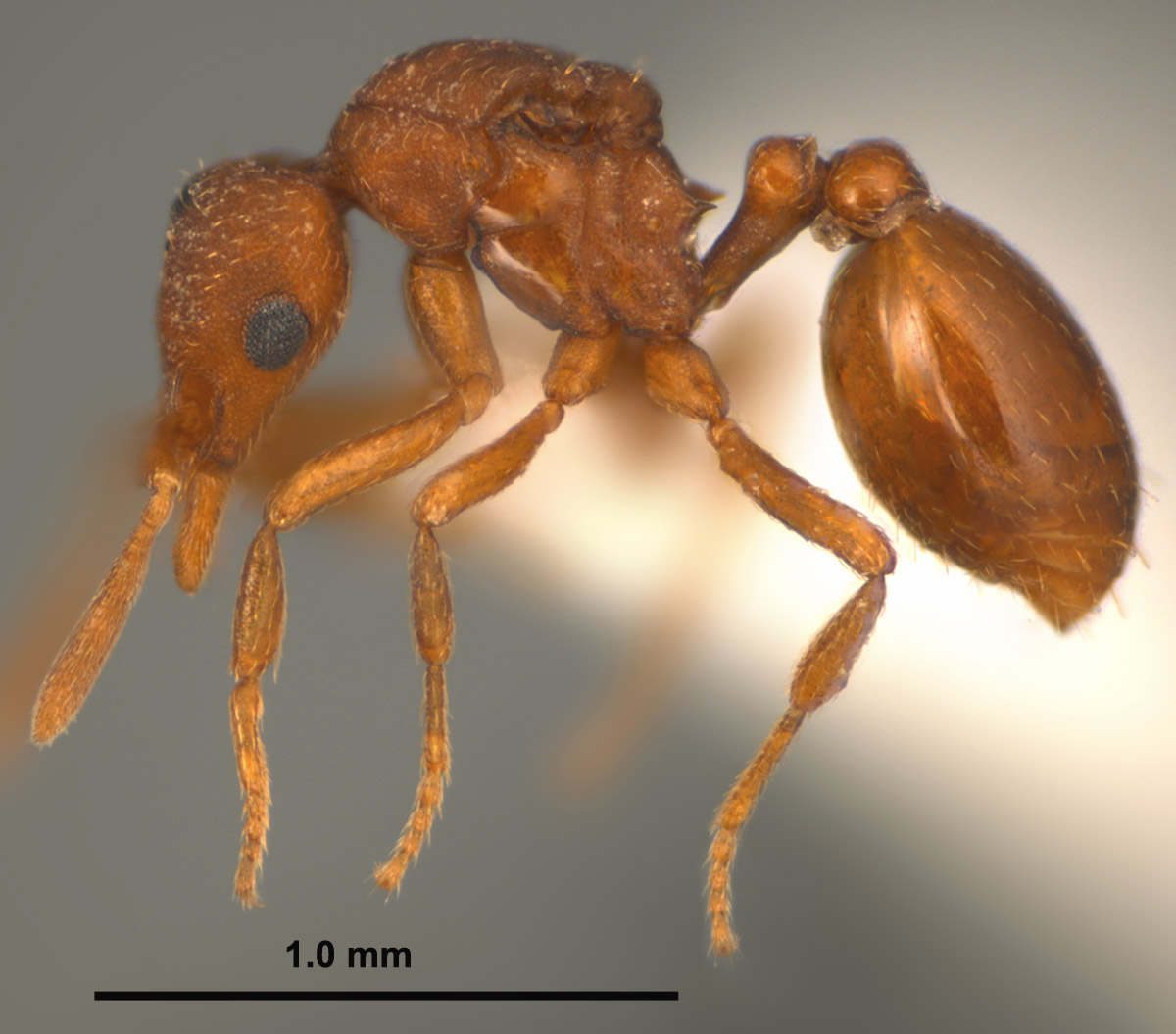Introduction
The genus Strumigenys is composed of minute, cryptic ants that typically occur in soil and leaf litter and prey upon small arthropods (Hölldobler and Wilson 1990). In North America, species can be characterized by having six-segmented antennae; triangular to subtriangular mandibles that are well separated and possess distinct dentition; specially modified hairs on some parts of the body that may be clavate, spoon-shaped, forked, or otherwise atypical; and the usual presence of spongiform tissue below the petiole and postpetiole.
Strumigenys subnuda was described from a single specimen of a dealate queen collected in Mississippi. Additionally, eight alate females that were collected in 1998 and 1999 in Saint Tammany Parish, Louisiana were discovered in material identified as Strumigenys margaritae in the Louisiana State Arthropod Collection.
Identification [Note: only known from a single queen]
Strumigenys subnuda can be characterized by its concolorous yellowish-brown body and appendages; pyriform head in frontal view; mandible triangular, lacking diastema, with basal lamella triangular and rounded at tip and followed by five prominent teeth of which 1, 3, and 5 are the longest, then two slightly smaller teeth with tooth 7 longer than 6, then four minute denticles, and terminating in a longer apical tooth; componnd eyes large, with 12 facets in greatest diameter (queen); head, alitrunk, petiolar stalk, and coxae with reticulate-punctate sculpture except most of katepisternum and anepisternum, which are mostly lacking sculpture and shining; gaster shining; hairs on body mostly appressed simple to coarse hairs except for longer simple to bifurcate erect hairs at sclerite edges; spongiform tissue lacking beneath petiole and gaster, and spongiform tissue reduced beneath postpetiole.
In North America, S. subnuda is most similar to S. margaritae, from which it differs by the following: in S. subnuda , hairs on the body are slightly coarse to slightly clavate, whereas in S. margaritae, all hairs on the head, mesosoma, waist, and gaster are distinctly clavate and somewhat translucent, more erect, and more abundant; the mesopleuron and dorsum of petiole and postpetiole are smooth and shining in S. subnuda , whereas they are reticulate-punctate in S. margaritae; thepropodeal spine length is much shorter in S. subnuda ; and the gaster is only weakly shagreened, appearing shiny in S. subnuda , whereas it is densely striolate-punctate to shagreened with dense striolae in S. margaritae. The only other species ofStrumigenys lacking or with reduced spongiform appendages known to occur in the United States is S. inopina Deyrup and Cover. Strumigenys inopina is easily separated from S. subnuda by its more triangular shaped face, entire side of the mesosoma being shiny, having numerous, dense, long hairs, and total absence of spongiform appendages beneath the postpetiole.
Biology and Economic Importance
The biology of this species is unknown. However, the type specimen was collected in grass clippings piled at the base of Quercus falcata Michx. (Fagaceae) in an open area near Jeff Davis Lake, (Jefferson Davis County) with scattered trees present. A mixed hardwood-pine forest surrounded the entire area. Other ants collected in the same Berlese sample included Brachymyrmex patagonicus Mayr, Hypoponera opaciceps (Mayr), Strumigenys membranifera Emery, Cyphomyrmex rimosus (Spinola), Solenopsis invicta Buren, and Pheidole moerens Wheeler, all of which are considered to be exotic species. Specimens from Louisiana were collected in longleaf pine savanas with the use of flight interception traps.
This species is unlikely to pose any economic problems.
Distribution
This species has only been collected in Jefferson Davis County, MS and Saint Tammany Parish, LA. .
Literature Cited
Hölldobler, B., and E.O. Wilson. 1990. The Ants. Belknap Press of Harvard University Press, Cambridge, MA. 732 pp.
MacGown, J. A. and J. G. Hill. 2010. A new species of Pyramica Roger (Hymenoptera: Formicidae) from Mississippi, U.S.A. Florida Entomologist. 93: 571-576. [pdf]




